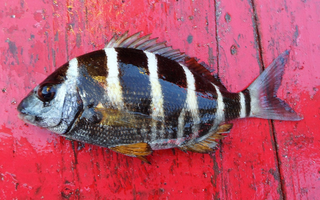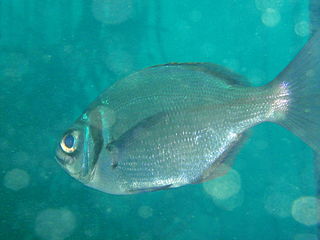
The panga, or panga seabream is a species of marine ray-finned fish belonging to the family Sparidae, which includes the seabreams and porgies. It is the only species in the monospecific genus Pterogymnus. This species is endemic to the coasts of South Africa. The panga is an important species in commercial line fisheries off South Africa.

The red steenbras is a species of fish in the family Sparidae and the only known member of the monospecific genus Petrus. This species is endemic to South Africa. The species' population has been depleted by overfishing in African waters and it has been classified as an endangered species by the International Union for Conservation of Nature.

Boops is a genus of marine ray-finned fishes belonging to the family Sparidae, the seabreams and porgies. There are two species in this genus, one in the Western Atlantic and Mediterranean, and the other in the Western Indian Ocean.

Diplodus is a genus of marine ray-finned fish belonging the family Sparidae, which includes the seabreams and porgies. These fishes are found in the Atlantic Ocean, the Mediterranean Sea and the western Indian Ocean.

Sparidentex is a genus of ray-finned fish belonging to the family Sparidae, which includes the seabreams and porgies. These fishes are found in the Indian Ocean.

Rhabdosargus is a genus of ray-finned fish belonging to the family Sparidae, which includes the seabreams and porgies. These fishes are found in the southeastern Atlantic Ocean and throughout the Indo-West Pacific, although mainly in the western Indian Ocean.

Cheimerius is a monospecific genus of marine ray-finned fish belonging to the family Sparidae, the seabreams and porgies. The only species in the genus is Cheimerius nufar, the santer seabream, santer or soldier, of the Indian Ocean.

Polysteganus is a genus of ray-finned fish belonging to the family Sparidae, which includes the seabreams and porgies. The fishes in this genus are found in the Indian Ocean.

Crenidens is a small genus of three species of seabream from the family Sparidae from the western Indian Ocean. It was previously regarded as monotypic, with the sole species being the Karenteen sea bream Crenidens crenidens but two other species are now accepted as valid species, separate from the type species, C. crenidens.

The banded seabream is a species of marine ray-finned fish belonging to the family Sparidae, which includes the seabreams and porgies. This species is endemic to Cape Verde in the eastern Atlantic Ocean.

Sparodon, commonly known as the white musselcracker, musselcracker seabream, mussel cracker seabream, brusher, or cracker. is a monotypic genus of fish in the family Sparidae. The type and only known species, Sparodon durbanensis, was first described and named by François Louis Nompar de Caumont de Laporte, comte de Castelnau, in 1861.

Argyrozona is a monospecific genus of marine ray-finned fish belonging to the family Sparidae, the seabreams and progies. Its only species is Argyrozona argyrozona, the carpenter seabream or doppie, which is endemic to the waters off southern South Africa.

Spondyliosoma is a genus of marine ray-finned fish belonging to the family Sparidae, which includes the seabreams and porgies. The genus contains two species, one, the black seabream, from the eastern Atlantic Ocean and the other, the steentjie seabream, from the western Indian Ocean.

Chrysoblephus is a genus of marine ray-finned fishes belonging to the family Sparidae, the sea breams and porgies. The fish in this genus are found in the western Indian Ocean and southeastern Atlantic Ocean.

Booposoidea is a monospecific genus of marine ray-finned fish belonging to the family Sparidae, the seabreams and porgies. The only species in the genus is Boopsoidea inornata, the Fransmadam or Karel grootoog, which is endemic to the southwestern Indian Ocean off South Africa.

Pachymetopon is a genus of marine ray-finned fishes belonging to the family Sparidae, which includes the seabreams and porgies. The species in this genus are endemic to Southern Africa.

Pachymetopon grande, the bronze seabream or blue hottentot, is a species of marine ray-finned fishes belonging to the family Sparidae, which includes the seabreams and porgies. This species is found in the southwestern Indian Ocean. It is an important spoecies for recreational fisheries in South Africa and for subsistence fisheries too.

Polyamblyodon is a genus of marin ray-finned fishes belonging to the family Sparidae, which includes the seabreams and porgies. The fishes in this genus are found in the Western Indian Ocean.

Polyamblyodon germanum, the German seabream, is a species of marine ray-finned fish in the family Sparidae, which includes the seabreams and porgies. This species is found in the southwestern Indian Ocean.

The Dane seabream, also known as the Dane, is a species of marine ray-finned fish belonging to the family Sparidae, which includes the seabreams and porgies. The Dane seabream is the only species in the monospecific genus Porcostoma. This species is endemic to the southwestern Indian Ocean off the coast of Southern Africa.



















